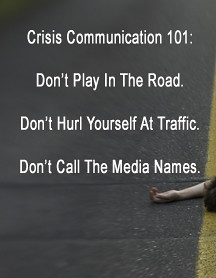Sometimes elected officials are only as good as their advisors. One wonders what Nevada Gov. Jim Gibbons’ advisors were thinking recently, allowing the governor to address the crisis surrounding the Endoscopy Center of Southern Nevada, almost a full month late, without the most basic facts, and without any sense of empathy for those affected.
Instead, he came out against the media, criticizing them for their “buffoonery” in covering the health crisis caused by the Endoscopy Center and downplaying the roll of majority owner Dr. Dipak Desai, despite mounting public testimony that Desai and other doctors directed nurses to employ unsafe practices.
John L. Smith, columnist for the Las Vegas Review-Journal, lists dozens of mistakes made by the governor today. Smith likens him to a clown, with a rubber nose and oversized bow tie. David McGrath Schwartz of the Las Vegas Sun called it a crisis response dance.
Papers across the state have published similar reviews, likening the stunt to playing in traffic. It hardly matters that the governor regretted his words the next day.
“My intention was to be sure that people were not fearful of seeking medical care because of the intense media coverage, it was a poor choice of words and I regret it,' Gibbons had said, referring to “buffoonery.”
He might regret them even more. After several members of the Nevada State Board of Medical Examiners revealed ties to the Endoscopy Center of Southern Nevada and recused themselves from any investigation, Gibbons called for their resignations as well as that of the board’s executive director. Some publicly stated today that they have no intention of stepping down. Maybe they sense the obvious.
But this post isn’t about the governor. It’s about communication.
If the intent of the communication was to instill confidence in a health care system under fire, the better message needed to be about 180 degrees different. What could it have been? Here is a five-minute solution, painfully better than the one delivered over the weekend.
• There is a health care crisis; empathy for those affected
• That any Nevadans (regardless how few) are affected is not acceptable or tolerable
• There are many excellent doctors doing their best to help statewide
• There is a cross-agency investigation being undertaken by the state
• A task force is making recommendations to ensure it does not happen again
• Board members with conflicts of interest might ask themselves if they can meet their obligations to the state
• But above all, if you or a loved one is affected, it is important for you and your family to be tested. It’s the right and responsible thing to do.
In addition, the state could have recognized several medical facilities that are offering educational seminars to help people who need to be tested. And, it could have urged Nevadans to give blood. Donations at United Blood Services’ five fixed sites have dropped 25 percent since the crisis began in early March.
That is the message the state needed. Instead, the wrong message had the opposite impact. It has further shaken the citizens’ confidence in the center, in the health care system, and in the state.
It didn’t have to be that way. Crisis communication 101 suggests that you never adopt someone else’s crisis as your own. Or, in other words, no brand is so invincible that it belongs playing in the road against oncoming traffic while cursing at delivery boys when they drive by. You know, they don't ride bicycles anymore. Someone might get hurt.

Instead, he came out against the media, criticizing them for their “buffoonery” in covering the health crisis caused by the Endoscopy Center and downplaying the roll of majority owner Dr. Dipak Desai, despite mounting public testimony that Desai and other doctors directed nurses to employ unsafe practices.
John L. Smith, columnist for the Las Vegas Review-Journal, lists dozens of mistakes made by the governor today. Smith likens him to a clown, with a rubber nose and oversized bow tie. David McGrath Schwartz of the Las Vegas Sun called it a crisis response dance.
Papers across the state have published similar reviews, likening the stunt to playing in traffic. It hardly matters that the governor regretted his words the next day.
“My intention was to be sure that people were not fearful of seeking medical care because of the intense media coverage, it was a poor choice of words and I regret it,' Gibbons had said, referring to “buffoonery.”
He might regret them even more. After several members of the Nevada State Board of Medical Examiners revealed ties to the Endoscopy Center of Southern Nevada and recused themselves from any investigation, Gibbons called for their resignations as well as that of the board’s executive director. Some publicly stated today that they have no intention of stepping down. Maybe they sense the obvious.
But this post isn’t about the governor. It’s about communication.
If the intent of the communication was to instill confidence in a health care system under fire, the better message needed to be about 180 degrees different. What could it have been? Here is a five-minute solution, painfully better than the one delivered over the weekend.
• There is a health care crisis; empathy for those affected
• That any Nevadans (regardless how few) are affected is not acceptable or tolerable
• There are many excellent doctors doing their best to help statewide
• There is a cross-agency investigation being undertaken by the state
• A task force is making recommendations to ensure it does not happen again
• Board members with conflicts of interest might ask themselves if they can meet their obligations to the state
• But above all, if you or a loved one is affected, it is important for you and your family to be tested. It’s the right and responsible thing to do.
In addition, the state could have recognized several medical facilities that are offering educational seminars to help people who need to be tested. And, it could have urged Nevadans to give blood. Donations at United Blood Services’ five fixed sites have dropped 25 percent since the crisis began in early March.
That is the message the state needed. Instead, the wrong message had the opposite impact. It has further shaken the citizens’ confidence in the center, in the health care system, and in the state.
It didn’t have to be that way. Crisis communication 101 suggests that you never adopt someone else’s crisis as your own. Or, in other words, no brand is so invincible that it belongs playing in the road against oncoming traffic while cursing at delivery boys when they drive by. You know, they don't ride bicycles anymore. Someone might get hurt.























